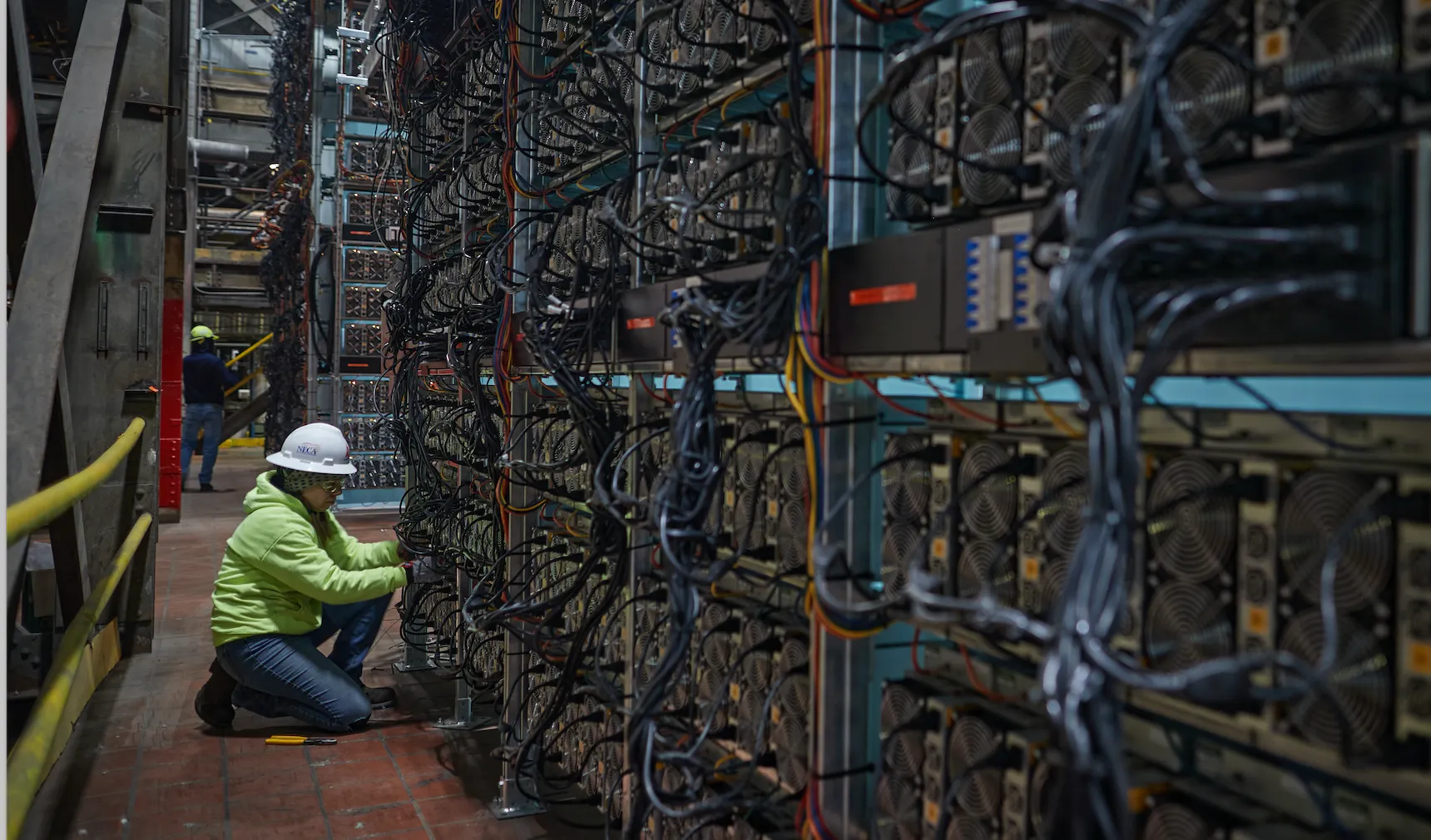In brief
- Energy company Greenidge Generation has pivoted to Bitcoin mining using a coal-fired power plant in Dresden, New York.
- Environmentalists fear that these plants herald the start of a new business model that threatens New York’s climate goals.
The Finger Lakes region is one of New York state’s most picturesque, but the natural beauty helps conceal the pain of a region hard hit by industrial decline.
Now, some are introducing a new type of industry to the area—Bitcoin mining, which offers an opportunity for digital wealth, but which has also generated a flurry of opposition from environmentalists determined to stop it.
Greenidge Generation is at the center of the fight. The company began as a coal-fired power plant in 1937, but recently pivoted to Bitcoin mining under cleaner natural gas, and argues it is complying with all of New York state’s environmental regulations. That’s not good enough for green activists who claim Greenidge’s facility not only harms the planet, but could pose a fatal blow to New York’s climate change ambitions.

The conflict has drawn media attention not just in New York but around the world. While Greenidge currently mines just four Bitcoin per day, it has become a symbol for those who say Bitcoin is a needless waste of power in a world struggling to reduce energy use.
‘Burning Natural Gas 24/7’
Greenidge Generation describes itself as a Bitcoin mining facility with an in-house power plant, drawing on a supply of natural gas to create the electricity necessary to mine Bitcoin around the clock.
While natural gas is a fossil fuel—a power source many countries are trying to eliminate altogether—it’s cleaner than other fossil fuels like coal. According to the U.S. Energy Information Administration, natural gas emits about 117 pounds of carbon dioxide per million British thermal units (MMBtu)—a figure that is more than 40% lower than coal’s 200 MMBtu.
How it started How it's going pic.twitter.com/cE7lxqJE7Z
— Greenidge Generation (@GreenidgeLLC) October 14, 2020
But the carbon impact of natural gas still far exceeds renewable alternatives like solar or wind power. And environmentalists are up in arms over the fact Greenidge Generation is using natural gas to mine Bitcoin.
“It’s not environmentally friendly,” Mandy DeRoche, deputy managing attorney at Earth Justice, told Decrypt, adding, “I don't think burning natural gas 24/7 at a power plant that was previously closed, except for a couple of days in the summer or winter, is compliant with GHG emission reduction targets anywhere.”
Some New York lawmakers share DeRoche’s concern.
In response, State Senator Kevin Parker (D) introduced a bill in the body’s Environmental Conservation Committee earlier this month. If it’s approved, Bitcoin mining centers will only be able to operate after a full review of the industry’s impact on the environment—a process that could take as long as three years.
I have introduced legislation that will require NYSERDA to study cryptocurrency mining centers in NYS & access whether cryptomining can be conducted by renewable energy.
It would also study the benefits of cryptomining through renewable energy: job creation and local employment. pic.twitter.com/A6Ns8ovXVy— Senator Kevin Parker (@SenatorParker) May 11, 2021
“The continued and expanded operation of cryptocurrency mining centers will greatly increase the amount of energy usage in the State of New York,” the bill reads, while also stating that mining activity could cause the state to miss greenhouse gas targets required by law.
The bill threatens not only Greenidge but other Bitcoin mining operations popping up in the state, and could serve as a model for other U.S. states and countries looking to curb crypto operations. In China, meanwhile, the government of Inner Mongolia has already come down hard on mining due to its impact on the environment.
Bitcoin mining: a dirty business?
Greenidge Generation, unsurprisingly, believes the proposed New York law is misguided. In pushing back against the measure, the company points out that it already requires special permission to run its facility in the town of Dresden, NY.
That permission comes in the form of a Title V permit, which compels a facility to monitor and control the amount of greenhouse gas emissions a facility can produce every year. Greenidge obtained its last Title V permit in 2016, and is hoping to get a renewal this September.

On March 25, Greenidge submitted a package of documents in support of its renewed application to the Department of Environmental Conservation in New York. That package contained a letter, seen by Decrypt, that specifies the legal maximum emissions the Greenidge facility can produce under its current Title V permit.
The company’s Dresden facility has permission to emit up to 641,000 tons of carbon dioxide equivalents per year. Decrypt has asked the company for the actual emissions produced by the facility, but to date it has not provided this data. To put that 641,000 figure into context, the Environmental Protection Agency’s own carbon emissions calculator suggests the company’s maximum legal emissions would amount to about 708 million pounds of burned coal, 116 thousand homes’ average electricity consumption for the year, or 1.6 billion miles driven by a passenger vehicle.
The environmental impact of the Greenidge plant can also be assessed in light of Bitcoin’s overall carbon footprint. Decrypt has previously reported that the output from Bitcoin’s non-renewable energy sources—including natural gas like Greenidge uses—is approximately 80 terawatt-hours of power per year. If the Greenidge facility emits its upper maximum of carbon dioxide per year, that would translate to about 1% of the overall carbon footprint generated by all Bitcoin miners that rely on non-renewable energy—a hefty slice of the pie for just one facility.
Despite this potential impact, DeRoche of Earth Justice told Decrypt that she fears Greenidge’s air emissions permit will be renewed without any real scrutiny. “As a general matter, these permits are renewed as business as usual. The same thing is going to happen here, they’re going to be operating within their permits, and no one can take a look at their operations,” said DeRoche.
In response, DeRoche and Earth Justice sent a letter to New York’s environmental regulator warning that Greenidge’s activities are part of a growing trend in the state of retired power plants launching Bitcoin mining operations.
That trend includes Fortistar North Tonawanda, another New York-based power plant that the blockchain firm Digihost Technology Inc. intends to use to mine Bitcoin.
Environmentalists fear that these plants represent the start of a new business model that threatens New York’s climate goals. Those goals, set out in state law, oblige the state to generate 70% of its electricity from clean energy sources by 2030, and 100% by 2040.
"If other plants like Greenidge are converted to Bitcoin mining, then I don’t see how we can meet our emissions goals."
“If Greenidge ramps up, expands, or if other plants like Greenidge are converted to Bitcoin mining, then I don’t see how we can meet our emissions goals,” said DeRoche, adding, “They’re supposed to be dead power plants, they were retired for a reason.”
Greenidge pushes back
In conversation with Decrypt, Greenidge Generation CEO Dale Irwin pushed back against some of the criticism his company—and the wider Bitcoin mining industry—has received. For one, Irwin rejected the argument that Greenidge, a former coal-powered plant, was simply resurrected to mine Bitcoin.
“You have got to make sure you do not represent this as a retired coal facility that was re-energized for the sake of Bitcoin,” he said. Greenidge ran test pilots for mining in 2019, two years after it reopened as a natural gas facility.
He also said that Greenidge’s business model does not provide—as Mandy DeRoche of Earth Justice claims—a blueprint for other retired power plants to follow suit. “They say ... ‘Oh, they’re going to bring back 30 plants,’ no, no they’re not,” he said.
Irwin also pointed to the fact that Greenidge helps upstate New York grow its economy. “Currently we have about 35 employees, and when we expand we’re going to push that number up to the high 40s to 50,” he said, adding, “And it’s really important to realize that our average wage per employee here at the facility is twice the average of our surrounding community.”
According to Town Charts—which uses economic analysis from the 2020 Census Bureau—median wages in Dresden are $38,214 per year. Meanwhile, Irwin says the average wage at the Greenidge facility is $77,000.

Whether Greenidge does or does not set a precedent for other would-be miners in the state, Irwin told Decrypt he plans to move the facility away from natural gas in the future, anyway—a plan spurred in part by the impending legal requirement that 70% of New York’s electricity must be sourced by renewable energy by 2030. When asked specifically if he was committed to moving away from natural gas, Irwin said, “We are committed, and at the end of the day, we have no choice.”
"We are committed [to moving away from natural gas], and at the end of the day, we have no choice."
Until then, the company plans to offset 100% of its carbon emissions through a “voluntary purchase” or greenhouse gas reduction projects. “We hope to offset 100% of our emissions of our mining operation,” Irwin said.
Where does Bitcoin mining in New York go next?
Greenidge’s mining operation is a controversial business but also a lucrative one. Today, the facility mines about 3.8 to 4 Bitcoins per day, meaning it now makes around $150,000 per day based on recent prices—a big increase from the $50,000 figure it disclosed to media outlets back in March 2020.
Irwin believes the company is providing a valuable service not only to the surrounding area, but to individuals around the world that use Bitcoin as an economic lifeline. “People see the benefits in Argentina where they wake up to 5,000% inflation. People see the benefits in Nigeria, where 32% of the population is utilizing Bitcoin, 100 million people around the world are utilizing Bitcoin,” Irwin said.
This argument doesn’t persuade environmentalists like DeRoche, who argue that abstract benefits like the ones touted by Greenidge don’t outweigh the harm caused by the greenhouse gases the company is pouring into the atmosphere.
And this debate is coming to a head. The Senate bill proposing a three-year moratorium on the mining industry appears to have momentum, though its chances of passing are unclear. New York Governor Andrew Cuomo has yet to weigh in, but he has previously described ignoring climate change as gross negligence—suggesting he would be open to signing it.
Climate change is a reality. Not addressing it is gross negligence.
— Andrew Cuomo (@NYGovCuomo) September 23, 2020
Some, however, are marshaling to kill this bill. “There’s very strong opposition to this bill from a variety of groups in New York,” Irwin said, specifically mentioning the International Brotherhood of Electrical Workers (IBEW). “Those groups believe that a moratorium, or something that is already covered by the state’s environmental regulations and producing enormous benefits, would be a mistake,” he added.
Meanwhile, New York and Greenidge are also players in a wider geopolitical game. Namely, China still holds about two-thirds of the world’s Bitcoin mining industry, which has led some to warn the United States is ceding control of a key strategic asset to its biggest rival.
In the U.S., Bitcoin mining has ticked up of late, growing to almost 8% of the global share compared to the 4% it was mining in September 2019. Meanwhile, in March of this year, UK-based firm Argo Blockchain bought land in Texas to launch a Bitcoin mining operation while US firm Riot Blockchain also dropped over $600 million on a massive Bitcoin mining site in the state. Those investments could translate into political capital and help American miners stave off broader regulation.
As for Greenidge, Irwin claims Bitcoin mining is here to stay, and we’d all be better off if it flourished in New York—where regulations are clear—than in China, where many mining operations operate with coal and without clear rules.
“It’s always better to have environmental regulations that are known, measured, and communicated is definitely better than someplace that it’s not known, it's not communicated, it’s not measured and it’s all estimated,” he concluded.

